|

|
Flackernd steigt die Feuersäule
Durch der Straßen lange Zeile
Wächst es fort mit Windeseile
Kochend wie aus Ofens Rachen
Glühn die Lüfte, Balken krachen
Pfosten stürzen, Fenster klirren
Kinder jammern, Mütter irren
Tiere wimmern
unter Trümmern
Alles rennet, reitet, flüchtet
Taghell ist die Nacht gelichtet
Heulend kommt der Sturm geflogen
der die Flamme brausend sucht
|
Climbs the fire column glowing
Through the streets' long rows it's going
Forth it goes with wind's speed growing
As in jaws of ovens cooking
Glows the air, the beams are cracking
Pillars tumble, windows quav'ring
Children wailing, mothers wand'ring
Whimp'ring cattle
Under rubble
All is running, saving, flying
Bright as day the night is shining
Howling comes the storm a-flying
Which doth seek the roaring flames.
|
Aus Friedrich Schiller, Lied von der Glocke
Der Bombenkrieg über der Ruhr aus dem Blickwinkel der alliierten Bomberbesatzungen der Royal Air Force und des US Air Corps
Report and Comments: Bennet/Crew, Royal Air Force. Raid to Gelsenkirchen on June 12th, 1944, Nord- stern, Gelsenberg Plant
RAF Wickenby (1 Group), Lincolnshire, England
F/O Bob Bennet - Operations Record May/Aug 1944 and further writings from the Navigator, Mid-Upper gunner and Bomb Aimer of the crew of Bennet's Beavers.
F/O Bennet/Crew posted to RAF Wickenby: 626 Squadron - 10 May 1944
Pilot - F/O Bennet (Bob)
Engineer - Sgt. Johnson (Johnny)
Bomb Aimer - Sgt. Robson (Robbie)
Navigator - Sgt Hayton (Harry)
Wireless Op - Sgt Scales (Tommy)
Mid Upper Gunner- Sgt Thatcher (Jim)
Rear Gunner - Sgt Smallshaw (Gerry)
12 June 1944: Op 8: Lancaster R2: F/O Bennet/Crew
Pilot's comments: Gelsenkirchen Oil refinery - Ruhr Valley. Heavy and light flak- hit twice. Terrific fire and column of smoke seen at target. Bomb load 12000 lbs.
Navigator's comments: (near Essen), in the Ruhr. Target was oil refinery in the heavily industrialized RUHR of Germany.
We dropped 12000 lbs of H.E. Very heavy flak and searchlight activity. We sustained damage from flak. We viewed enormous fires and large columns of smoke over the target area. Duration 4 hrs 40 mins. WE HATED GOING TO THE RUHR!
Mid-Upper Gunner's comments: Gelsenkirchen, Ruhr Valley, Germany. Target synthetic oil plant in Happy Valley. Bomb load cookie (4000 lbs) plus 1000 pounders. Bombed at 20.000 Ft. Very heavy flak barrage and intense fighter activity - a wonder we ever got back. Hit in two places by flak. Noted A/C going down in target area and as far as coast. Trip 4 hours 40 minutes. Lost 2 A/C from 12 Squadron - same station.
Bomb Aimer's recollections: We were hit by flak and my size saved my life. I am only 5' 51/2" so sat fairly low in the front turret. A jagged piece of shrapnel about the size of an ostrich egg hit the plane and lodged about 3 inch above my head.
Incidental:
303 aircraft - 286 Lancasters and 17 Mosquitos of Nos 1, 3 and 8 Groups - carried out the first raid of the new oil campaign; the target was the Nordstern synthetic-oil plant at Gelsenkirchen (the Germans called the plant Gelsenberg AG). 17 Lancasters were lost, 6,1 percent of the Lancaster force. The attack opened with exceptional accuracy owing to good work by the Pathfinders and to improved versions of Oboe sets now available. Later phases of the bombing were spoiled by the clouds of smoke from the burning target and by a rogue target indicator which fell 10 miles short of the target and was bombed by 35 aircraft. A German industrial report shows that all production at the oil plant ceased, with a loss of 1,000 tons of aviation fuel a day for several weeks, as well as the loss of other fuels.
http://www.bBomber Command.co.uk/ww2peopleswar/user/68/u1456068.shtml
The raid on the 18th of July 1944:
A Hell of a Fright
The same night taking off in K2 "Killer" at 2300 for our ninth raid on oil installations at Gelsenkirchen, had us realising how tired we were. We had taken off in the morning at 0335 which meant we had started our preparations and meals before midnight, and yet here we were again airborne at 2300 hours. After take off we climbed for a height of 12,000ft at our rendezvous point over Mablethorpe.
We had on board our first loading of the block buster 4,000lb bomb, known and easily identified as "Cookie", The total bomb load was one 4,000 lbs. and sixteen 500 lbs. filling all possible bomb stations.
The 4,000lb Cookie had a thin casing, which increased to four times its normal size then exploding. This factor created the blast effect. It was also dangerous, as had been proven when the bomb dropped from a plane to the ground in the dispersal. The bomb had exploded wiping out the plane and also damaging adjacent planes.
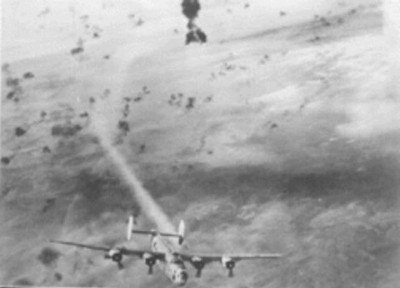 "This one belongs to 457th Bomb Group of the United States Air Corps attacked by Flak over 'Flak-Alley'"
If hit in the bomb bay by a piece of ack ack, and the cookie exploded there was nothing left after the blast. The crew was always very happy when the Cookie had been dropped. It always felt so much safer, not having it riding just under our feet, with only a thin aluminium floor between the bombs and us. This was our first block buster "Cookie". It was for maximum blast effect in
the oil installations, and hopefully this would cause a lot of property damage. It was also our first raid into the Ruhr Valley, and we had been briefed to fly on a route avoiding bad ack ack locations. Flying a circuitous route from Mablethorpe to 53 00'N 03 00'E to 52 35'N 04; 35'E to 52 20'N 07 05'E then the target (marked in our log books thus) then 51 38'N 06 20'E to 52 20'N 05 20'E to 52 20N 03 00'E then Cromer - Mablethorpe - Base.
|
These different courses were set up hoping to confuse the German defences and the fighter controllers, for a little while. We always hoped that the ploy would work and keep the fighters away, but we seemed to attract fighters like bees to a honey pot. It was a deadly guessing game. Which way was the raid , and where was the best place for the fighters to intercept the raiding bombers? It was a constant battle to see who could outwit the opposing forces, and gain an advantage. We had been told to expect a concentration of about 300 searchlights, with a possibility of around 500 ack ack positions. The numbers didn't mean very much, excepting it sounded like, and turned out, a terrific amount of defences. How can one describe flying into a rainstorm of ack ack shells bursting all round us, of violent explosions in the air, of explosions on the ground. The fighters and heavy flak 105mm and 128mm guns, bursting just around and above us as the gunners got onto our height.
The radar-guided 88mm guns which fired predicted flak and could pick off individual bombers at considerable heights. The lighter flak guns of 50mm, 37mm and 25mm, with their red green and yellow tracers arcing up toward us as though it was water being sprayed from a fireman's hose. All guns being fired as fast as the gunners could load them. It was quite a sight as rings of shock waves, came up out of the inferno on the ground, as the Cookies blasted many into eternity. These shock waves were like circles of shimmering light, ever widening, rising through the smoke and fires.
I was absolutely petrified. How could anyone survive this fusilade of death and destruction? Someone had said when you are really frightened get your mind on to something else. I started saying to myself "Into the valley of death, rode the six hundred, guns to the right of them, guns to the left of them".
"Yes, I'm thinking, what about the guns below them, and the ack ack shells curving upwards at my belly".
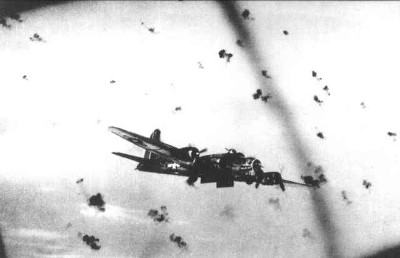 Abb.: B 17 "Flying Fortress" of the United States Air Corps attacked by Flak over Flak-Alley. (Nick-name, like Ruhr-Valley)
There goes a plane down in flames to port and another one underneath us. I grabbed my parachute putting it between my legs, and lay on it, at least perhaps I could preserve my manhood. This felt fine, and so my rolled up parachute was used on many more raids, for my personal comfort and protection. With perhaps five minutes left on the run into the target, all sorts of jumbled thoughts flew in and out of my head.
|
"The Lord is my shepherd I shall not want, He leadeth me beside still waters". "Into the valley of death rode the six hundred, and he will protect us". There go another two planes. They must have collided in this air alive with flak. "Surely goodness and mercy. Have mercy on us".
How could we possibly survive? The flak was unbelievable. I was shaking like a leaf and my thoughts were jumbled. I was beginning to wonder if I could drop the bombs because of my shaking. This waiting and watching and seeming to crawl up to the target was dreadful.
My thoughts were becoming more jumbled the closer we got to bomb dropping. Suddenly there was a blinding flash less than 100feet above us accompanied by a shocking blast which shook our plane and then the mid-upper's voice: "Gawd, he's blown up, and his engine, white hot, just missed me as it went down between our wing and our tail plane!" Ted had swung hard, when the explosion occurred and this had possibly saved us from the engine, which just missed the fuselage of our plane. It was time to bomb and suddenly, after this violent manoeuvre threw me against the side of the plane and the blast of the explosion, I was as cool as a cucumber.
"Bomb aimer to Skipper, bomb doors open".
"Left, left, 20 degrees".
"Steady------------Steady-----------Right five degrees---------Steady-----------Steady----------bombs gone.
Close bomb doors-------hold for photo ------- hold------OK photo taken". I always tried to have the bomb doors open for the least possible time. I felt safer with them closed.
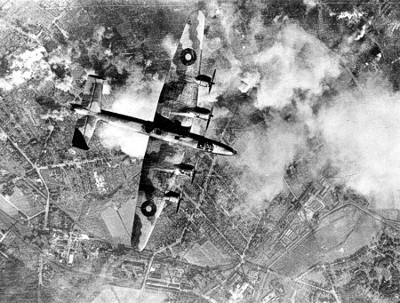 Abb.: 10.12.1944, bombing Wanne-Eickel (Imperial War Museum, London)
The fires and the explosions on this raid were awesome and unbelievable. On the run up to the target there was a terrific explosion and flames shot up 4/5,000 feet, so bright that the searchlights were blotted out momentarily. It appeared almost like day for about fifteen seconds. A smaller explosion, a minute later, indicated considerable damage had been done to the oil storage. As we flew out of the target area the German fighters were diving in among the bombers and the tracer bullets were flying in many directions.
|
On the ground the fires were lighting up the whole area, and it was satisfying to see we had hit the target area good and hard. Everyone was on tenterhooks with reports on fighters too close for comfort but, fortunately for us, they were not attacking us. Tracer bullets were flying from some of the planes and we saw a couple of fighters firing their cannon shells into one unfortunate bomber. After receiving two or three sustained bursts of fire the plane suddenly blew up, heeled over on its side and went down in flames. It all happened so quickly and the shell busts on the plane were so deadly that the crew didn't have a chance of parachuting.
On our return to base, as we climbed into the crew bus to be taken to interrogation, I heard one bright spark say "The flak was so thick we could have put our undercart down and landed on it". I was in silent agreement. Another crewman passed an opinion that those German fighter pilots sure had guts as they risked being shot down by their own flak over the target in their hunt to get a shot at one of the bombers, as well as risking being shot down by one of the bomber gunners.
Of course we all knew that over the target in the bombing run flying straight and level the bombers were at their most vulnerable. However we would raise our hats to the German fighter pilots and to their courage. When the aircrews came into the light at interrogation and again in the mess, they had a queer look about them. It suddenly struck me that their cheeks were sunken, and they were sullen with none of the usual spark and light chatter. Their eyeballs gave the impression of sticking out of their heads, and they were listless and moved like old men.
The two raids took 27 hours without a rest or sleep. The continual roar of the engines hour after hour, the nervous tension, and long hours were having their effect. The next morning making an inspection of our plane in daylight, Sgt. Bill Young and Cpl. Jack Hill (Melbourne) "K2" chief groundcrew climbed into "Killer" and came out looking very subdued when they discovered most of the top of the pilot's canopy had been blown out by the explosion.
With 34 individual holes in the top of our plane Bill Young's comments were "Jeez what happened last night, you poor buggers, don't worry, we'll soon have her fixed up like new!" and they wanted to know what had happened. Miraculously no one was injured, except for the awesome fright of our young lives.
On the return, many airmen didn't attempt to get food but headed to their rooms, where they just flopped down clothes still on, too fatigued to undress and get into bed. Most aircrew found it impossible to sleep after these raids. The mind seemed to go round in never ending circles, and we were only able to doze. The deafening roar of the engines was still with us for many hours. Still in our clothes, after 3 to 4 hours dozing, some of us drifted back to the mess for some food. Others had a pick at the meal. We all drank a lot of fluid because flying above 12,000 feet, we had to use oxygen which had a very drying effect on our bodies. We then usually headed back for a shower, mainly looking to moisten our bodies. Only then were we able to lie down and get some sleep.
Without oxygen at 20,000 feet, we were told we could only survive for four minutes. Therefore its use was absolutely necessary. Crew members always had to be alert at all times, to make sure none of their crewmates were suffering from lack of oxygen. When asked by the new crews what it was like over Germany, this raid became our measuring stick. "Wait until you raid Gelsenkirchen, then you will know
how tough it can get", became our standard reply. Speaking with Bert Uren, navigator in P/O G. Stone's crew he said they had Group/Capt. Hughie Edwards as their skipper on the Gelsenkirchen raid and the crew thought they were extremely lucky to survive. On the run up to the target almost on the point of bombing the mid upper gunner reported a bomber just above and he felt they might be hit by the bombs which he could see in
the open bomb bay just above them.
Group/Capt Edwards in his true "press on regardless manner" ignored the warning and when the 500lb bombs were released one bomb just missed the leading edge of the wing and the next bomb just missed the trailing edge. Almost immediately a plane just in front of them received a direct hit and with a blinding flash blew to pieces. It was possibly the same plane which blew up just above us. It was so close they flew through the debris from the plane which had been blown apart. How lucky can you be?
The Gelsenkirchen-Nordstern Mission
On one of the operations over the Gelsenkirchen-Nordstern area in Germany, my father's crew was unable to disperse their load the first time round and had to go back over the target area a second time. By the time the Halifax bomber reached home base in England, it had 17 holes in the wings and fuselage caused by German anti-aircraft fire. This mission won members of the crew the Distinguished Fly Cross.
The following excerpt is from "To See the Dawn Breaking: 76 Squadron Operations" (p 158) and describes the lead up to the raid over Gelsenkirchen ( see W. R. Chorley ).
My Father's Crew
My father (John Tindale) is no longer alive, but fellow crew member and life long friend, Fred Renshaw has been able to provide me with some of the details of crews members and events that took place, as well as the photos shown below. My father was one of an original group of five who started flying Wellingtons at Enfield in February 1944. This group initially included, Pilot Alan Dale, Navigator John Tindale, Bomb-aimer Bud (Isaac) Sewell, Rear-gunner Geoff Bailey, and Wireless operator/Air gunner Fred Renshaw . With the exception of the pilot, this group managed to stay together for the duration of the training and until the end of their tour of duty.
By the beginning of April 1944 the crew had a new pilot, an Australian by the name of Les Dowling. Les, a member of the Royal Australian Air Force, was already a seasoned veteran and had been hanging around the mess looking for a new crew. On his previous tour, Les's plane had taken enemy fire while on a raid over France. His plane aflames, he had ordered his crew to jump, while he alone stayed with the plane until he crash landed somewhere behind enemy lines. Les somehow managed to make his way across the Pyrenees to Spain and from there he found his way to England. Les had no intention of ever ending up in a crashing plane again, and somehow he managed to keep that promise to himself and his crew.
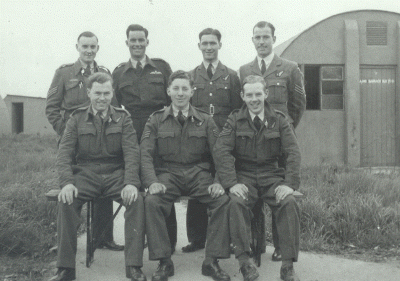 Abb.: Back Row: Les "Pop" Sutton: Middle-upper gunner, Les Dowling: Pilot, John Tindale: Navigator, "Bud" Sewell: Bomb aimer.
Front Row: Geoff Bailey: Rear gunner, Jim Burridges: Flight Engineer, Fred Renshaw: Wireless Op, Air/Gunner
"Meanwhile, the squadron was playing its role in attacks on beleagured enemy garrisons. Gun emplacements and strong points at Le Havre received a caning, two major raids being flown on the 10th leaving the defenders shocked and confused. Just before the middle of September, two attacks on synthetic oil installations at Gelsenkirchen were launched. Well over a year had passed since the squadron last visited this prime target, then one of the many objectives in the first Battle of the Ruhr. The first raid was aimed at a plant in the Buer district, commencing in the early afternoon of the 12th. A strong barrage of flak rose to buffet the mainforce pouring across the town between 17,000 and 18,000 feet. Nearly every squadron bomber was hit, though none broke station. Warrant Officer Les Dowling RAAF, however, decided to make a second run as Sergeant Geoff Bailey, one of his air-gunners, will now explain. "At the last moment cloud obscured the Aiming Point and the bomb-aimer did not press the release button. Then the cloud drifted clear, so the skipper plumbed for another go. By the time we started our second run we were practically on our own and the flak gave us a renewed hammering. Talk about sweating cobs, I was glad to see the back of Gelsenkirchen that day".
|
Schräge Musik
We had dropped our bombs on a synthetic-oil plant in Gelsenkirchen, Germany the night of June 12/13, 1944 and were headed for base. In the tail gun turret I was searching in the dark for any enemy fighters who might be following us out of the target area. Suddenly I heard cannons barking loudly and saw lights flashing directly below. What the hell was that? I didn"t see the fighter – just the flashing. We took evasive action and that was it.
At base the pilot told me he saw tracers streaking up in front of him at a steep angle. I wondered how a night fighter could be so very close under our Lanc and yet be able to fire upwards at about 70 degree angle. At that time we didn"t know about "Schräge Musik" – two upward firing cannons fitted in the rear cockpit of a Messerschmitt 110. Lucky for us the German pilot sneaked a bit too far forward and missed. According to "Bomber Command War Diaries" the first time the Luftwaffe used "Schräge Musik" was during the bombing of Peenemunde, August 17/18, 1943 and are believed to have shot down six bombers. I completed my tour of 31 Operatons on August 30, 1944 still wondering – "What the hell was that?"
In the Airmail section of the Winter 2000 issue of "Airforce" I see that J. McLean and a group of 36 Air-gunners, arrived in England in June 1944 and were sent directly into training and on to a squadron the first week in August 1944. McLean states: “This quick trip to squadron was necessitated so we could man the newly installed Ventral Gun Position on the Hallies to combat Schrage Musik…”. Since Bomber Command knew about the weapon in June, and perhaps earlier, I wonder why all squadron were not alerted and when were they alerted. I would like to hear from anyone who had any experience with those cannons, or any information you can give me.
Leonard J. Isaacson, 228 Corvette Crescent, Lethbridge, AB T1J 3X8, UK
May I add, as a Postscript, that even with the noises of the Lancasters, motors and wind, and with my helmet on and earphones over my ears, I very clearly heard the very loud barking of the cannons. There is no doubt in my mind that it was S.M. So – I decided to dig deep into the questions about S.M. and pass the info on to my ex-Bomber Command friends who have not heard, even yet, about S.M. and to some who doubt that it was ever in action. I can understand this, since it seemed to be such a secret. In all my searching I have found no one who had heard about the S.M. while on squadron. I have a lot of info about S.M. that my brother found on the Internet. However, what I have revealed should be evidence enough. Why were not all squadrons alerted? Perhaps the best answer I"ve had is from an ex-Navigator from 429 Squadron who completed 32 operations in a Halifax III. In a letter to me he said, “I"m sure that no historian will ever unearth any document which states the reason for not telling us, nor even one which states that we should not be told. The secret reason for this lack of information will probably die with the man who made the decision.”
"Schräge Musik" – a German nickname given to the Nachtjagd "Night Fighter Planes" equipped with two MG ff's or MG 151/20s 20mm cannons mounted in the cabin or fuselage at a 70-80 angle which were aimed by a second Revi C 12/D or 16B gun sight mounted on the canopy roof. "Schräge Musik" proved to be lethal and took a fearsome toll of heavy bombers in the night battles.
Battle of the Ruhr - Luftangriffe 1942 | ↑ Top |
| Datum | Einsatzstärke | Einheit | Ziel |
| 09./10.03. | 187 | Bomber Command | Essen, town area |
| 10./11.03. | 126 | Bomber Command | Essen, town area |
| 25./26.03. | 254 | Bomber Command | Essen, town area |
| 26./27.03. | 104 | Bomber Command | Essen, town area |
| 06./07.04. | 157 | Bomber Command | Essen, town area |
| 10./11.04. | 254 | Bomber Command | Essen, town area |
| 12./13.04. | 251 | Bomber Command | Essen, town area |
| 14./15.04. | 208 | Bomber Command | Dortmund, town area |
| 15./16.04. | 152 | Bomber Command | Dortmund, town area |
| 01./02.06. | 956 | Bomber Command | Essen, town area |
| 02./03.06. | 195 | Bomber Command | Essen, town area |
| 05./06.06. | 180 | Bomber Command | Essen, town area |
| 08./09.06. | 170 | Bomber Command | Essen, town area |
| 16./17.06. | 106 | Bomber Command | Essen, town area |
| 13./14.07. | 194 | Bomber Command | Duisburg, town area |
| 21./22.07. | 291 | Bomber Command | Duisburg, town area |
| 23./24.07. | 215 | Bomber Command | Duisburg, town area |
| 25./26.07. | 313 | Bomber Command | Duisburg, town area |
| 06./07.08. | 216 | Bomber Command | Duisburg, town area |
| 06./07.09. | 207 | Bomber Command | Duisburg, town area |
| 16./17.09. | 369 | Bomber Command | Essen, town area |
| 20./21.12. | 232 | Bomber Command | Duisburg, town area |
Battle of the Ruhr - Luftangriffe 1943
|
↑ Top
|
| Datum | Einsatzstärke | Einheit | Ziel |
| 05./06.03. | 442 | Bomber Command | Essen, town area |
| 12./13.03. | 457 | Bomber Command | Essen, town area |
| 26./27.03. | 455 | Bomber Command | Duisburg, town area |
| 29./30.03. | 155 | Bomber Command | Bochum, town area |
| 03./04.04. | 348 | Bomber Command | Essen, town area |
| 08./09.04. | 392 | Bomber Command | Duisburg, town area |
| 09./10.04. | 109 | Bomber Command | Duisburg, town area |
| 26./27.04. | 561 | Bomber Command | Duisburg, town area |
| 30./01.05. | 305 | Bomber Command | Essen, town area |
| 04./05.05. | 596 | Bomber Command | Dortmund, town area |
| 12./13.05. | 572 | Bomber Command | Duisburg, town area |
| 13./14.05. | 442 | Bomber Command | Bochum, town area |
| 23./24.05. | 826 | Bomber Command | Dortmund, town area |
| 27./28.05. | 518 | Bomber Command | Essen, town area |
| 12./13.06. | 503 | Bomber Command | Bochum, town area |
| 14./15.06. | 203 | Bomber Command | Oberhausen, town area |
| 22.06. | 235 | USAAF | Marl-Hüls, IG-Farben Buna-Werke; synthetic rubber plant |
| 22./23.06. | 557 | Bomber Command | Mülheim, town area |
| 25./26.06. | 473 | Bomber Command | Gelsenkirchen, town area |
| 09./10.07. | 418 | Bomber Command | Gelsenkirchen, town area |
| 25./26.07. | 705 | Bomber Command | Essen, town area |
| 12.08. | 330 | USAAF | Gelsenkirchen, Bochum; synthetic oil plant/marshalling yards, steel works |
| 29./30.09. | 352 | Bomber Command | Bochum, town area |
| 01./02.10. | 252 | Bomber Command | Hagen, town area |
| 05.11. | 374 | USAAF | Gelsenkirchen, synthetic oil plant/marshalling yards |
| 19.11. | 160 | USAAF | Gelsenkirchen, synthetic oil plant Gelsenberg AG. (Abbruch der Operation über dem Zielgebiet) |
Battle of the Ruhr - Luftangriffe 1944
|
↑ Top
|
| Datum | Einsatzstärke | Einheit | Ziel |
| 23.03. | 83 | USAAF | Hamm, marshalling yards (Zweitziel Münster) |
| 26./27.03. | 705 | Bomber Command | Essen, town area |
| 22.04. | 653 | USAAF | Hamm, marshalling yards. (Vorbereitung für die Invasion) |
| 26./27.04. | 493 | Bomber Command | Essen, town area |
| 21./22.05. | 532 | Bomber Command | Duisburg, town area |
| 22./23.05. | 375 | Bomber Command | Dortmund, town area |
| 31.05. | 54 | USAAF | Schwerte, marshalling yards ( Vorbereitung für die Invasion) |
| 31.05. | 51 | USAAF | Hamm, marshalling yards. (Vorbereitung für die Invasion) |
| 12./13.06. | 303 | Bomber Command | Gelsenkirchen, synthetic oil plant Gelsenberg AG |
| 16./17.06. | 321 | Bomber Command | Oberhausen-Sterkrade, synthetic oil plant Ruhrchemie AG |
| 21./22.06. | 132 | Bomber Command | Gelsenkirchen, synthetic oil plant Scholven |
| 18./19.07. | 170 | Bomber Command | Gelsenkirchen, synthetic oil plant Scholven |
| 20./21.07. | 166 | Bomber Command | Bottrop-Welheim, synthetic oil plant Ruhröl AG |
| 25./26.07. | 135 | Bomber Command | Wanne-Eickel, synthetic oil plant Krupp GmbH |
| 18./19.08. | 234 | Bomber Command | Oberhausen-Sterkrade, synthetic oil plant Ruhrchemie AG |
| 26.08. | 89 | USAAF | Gelsenkirchen, synthetic oil plant Scholven |
| 26.08. | 85 | USAAF | Gelsenkirchen, synthetic oil plant Gelsenberg AG |
| 11.09. | 134 | Bomber Command | Castrop-Rauxel, synthetic oil plant Gewerkschaft Victor. (Erster größere Tagesangriffe des Bomber Command auf Ziele im Ruhrgebiet) |
| 11.09. | - | USAAF | Bergkamen, synthetic oil plant |
| 11.09. | - | USAAF | Gelsenkirchen, synthetic oil plant Gelsenberg AG |
| 12.09. | 119 | Bomber Command | Dortmund, synthetic oil plant Hoesch-Benzin GmbH |
| 12.09. | - | USAAF | Gelsenkirchen, synthetic oil plant Scholven |
| 12.09. | - | USAAF | Wanne-Eickel, synthetic oil plant Krupp GmbH |
| 13.09. | 140 | Bomber Command | Gelsenkirchen, synthetic oil plant Gelsenberg AG |
| 19.09. | 186 | USAAF | Hamm, marshalling yards. (Unterstützung für "Market-Garden") |
| 19.09. | 64 | USAAF | Unna, Königsborn ordonance depot. (Unterstützung für "Market-Garden") |
| 26.09. | 274 | USAAF | Hamm, marshalling yards. (Unterstützung für "Market-Garden") |
| 27.09. | 175 | Bomber Command | Bottrop-Welheim, synthetic oil plant Ruhröl AG |
| 00.00. | 171 | Bomber Command | Oberhausen-Sterkrade, synthetic oil plant Ruhrchemie AG |
| 30.09. | 139 | Bomber Command | Oberhausen-Sterkrade, synthetic oil plant Ruhrchemie AG |
| 00.00. | 136 | Bomber Command | Bottrop-Welheim, synthetic oil plant Ruhröl AG |
| 26.09. | 274 | USAAF | Hamm, marshalling yards |
| 02.10. | 266 | USAAF | Hamm, marshalling yards |
| 06.10. | - | - | Oberhausen-Sterkrade, synthetic oil plant Ruhrchemie AG |
| 00.00. | - | - | Gelsenkirchen, synthetic oil plant Scholven |
| 06./07.10. | 523 | Bomber Command | Dortmund, town area Beginn der zweiten "Battle of the Ruhr", die bis Ende Dezember 1944 andauert |
| 09./10.10. | 435 | Bomber Command | Bochum, town area |
| 12.10. | 137 | Bomber Command | Wanne-Eickel, synthetic oil plant Krupp GmbH |
| 14.10. | 1013 | Bomber Command | Duisburg, town area Luftoperation "Hurricane I" |
| 14./15.10. | 1005 | Bomber Command | Duisburg, town area Luftoperation "Hurricane I" |
| 22.10. | 353 | USAAF | Hamm, marshalling yards |
| 23./24.10. | 1055 | Bomber Command | Essen, town area |
| 25.10. | 771 | Bomber Command | Essen, town area |
| 25.10. | 100 | USAAF | Hamm, marshalling yards |
| 25.10. | 91 | USAAF | Gelsenkirchen, synthetic oil plant Scholven |
| 26.10. | 65 | USAAF | Bottrop-Welheim, synthetic oil plant Ruhröl AG |
| 28.10. | 184 | USAAF | Hamm, marshalling yards |
| 30.10. | 209 | USAAF | Hamm, marshalling yards |
| 31.10. | 101 | Bomber Command | Bottrop-Welheim, synthetic oil plant Ruhröl AG |
| 01.11. | 113 | USAAF | Gelsenkirchen, synthetic oil plant Gelsenberg AG |
| 01.11. | 143 | USAAF | Gelsenkirchen, synthetic oil plant Scholven |
| 01./02.11. | 288 | Bomber Command | Oberhausen, town area/ marshalling yards |
| 02.11. | 131 | USAAF | Castrop-Rauxel, synthetic oil plant Gewerkschaft Victor |
| 02.11. | 107 | USAAF | Oberhausen-Sterkrade, synthetic oil plant Ruhrchemie AG |
| 04.11. | 91 | USAAF | Bottrop-Welheim, synthetic oil plant Ruhröl AG |
| 04.11. | 133 | USAAF | Gelsenkirchen, synthetic oil plant Gelsenberg AG |
| 04./05.11. | 749 | Bomber Command | Bochum, town area |
| 06.11. | 738 | Bomber Command | Gelsenkirchen, synthetic oil plant Gelsenberg AG |
| 06.11. | 87 | USAAF | Bottrop-Welheim, synthetic oil plant Ruhröl AG |
| 06.11. | 134 | USAAF | Oberhausen-Sterkrade, synthetic oil plant Ruhrchemie AG |
| 06.11. | 65 | USAAF | Duisburg, coking plant Bruckhausen |
| 09.11. | 277 | Bomber Command | Wanne-Eickel, synthetic oil plant Krupp GmbH |
| 11.11. | 122 | Bomber Command | Castrop-Rauxel, synthetic oil plant Gewerkschaft Victor |
| 11.11. | 100 | USAAF | Gelsenkirchen, synthetic oil plant Scholven |
| 11.11. | 124 | USAAF | Bottrop-Welheim, synthetic oil plant Ruhröl AG |
| 11./12.11. | 238 | Bomber Command | Dortmund, synthetic oil plant Hoesch-Benzin GmbH |
| 15.11. | 177 | Bomber Command | Dortmund, synthetic oil plant Hoesch-Benzin GmbH |
| 18./19.11. | 309 | Bomber Command | Wanne-Eickel, synthetic oil plant Krupp GmbH |
| 20.11. | 61 | USAAF | Gelsenkirchen, synthetic oil plant Scholven |
| 21./22.11. | 273 | Bomber Command | Castrop-Rauxel, synthetic oil plant Gewerkschaft Victor |
| 00.00. | 270 | Bomber Command | Oberhausen-Sterkrade, synthetic oil plant Ruhrchemie AG |
| 23.11. | 168 | Bomber Command | Gelsenkirchen, synthetic oil plant Gelsenberg AG |
| 29.11. | 134 | USAAF | Gelsenkirchen, synthetic oil plant Gelsenberg AG |
| 26.11. | 266 | USAAF | Hamm, marshalling yards |
| 28./29.11. | 316 | Bomber Command | Essen, town area |
| 29.11. | 311 | Bomber Command | Dortmund, town area |
| 29.11. | 294 | USAAF | Hamm, marshalling yards |
| 30.11. | 60 | Bomber Command | Bottrop, coking plant Mathias Stinnes AG |
| 00.00. | 60 | Bomber Command | Oberhausen, coking plant Zeche Osterfeld |
| 30./01.12. | 576 | Bomber Command | Duisburg, town area |
| 02.12. | 93 | Bomber Command | Dortmund, coking plant Zeche Hansa |
| 02./03.12. | 504 | Bomber Command | Hagen, town area |
| 04.12. | 160 | Bomber Command | Oberhausen, town area |
| 05.12. | 94 | Bomber Command | Hamm, marshalling yards |
| 08.12. | 163 | Bomber Command | Duisburg, marshalling yards Wedau |
| 11.12. | 150 | Bomber Command | Oberhausen, marshalling yards/coking plant Osterfeld |
| 12.12. | 140 | Bomber Command | Witten, steel works of Ruhrstahl AG and town area |
| 12./13.12. | 540 | Bomber Command | Essen, town area (Letzter größerer Nachtangriff des Bomber Command auf Essen) |
| 17./18.12. | 523 | Bomber Command | Duisburg, town area |
| 29./30.12. | 346 | Bomber Command | Gelsenkirchen, synthetic oil plant Scholven |
| 31./01.01. | 166 | Bomber Command | Oberhausen, marshalling yards Osterfeld |
Tabellen Battle of the Ruhr - Luftangriffe 1942, 1943 und 1944:
"The Mighty Eighth War Diary" by Roger Freeman, 1990 Motorbooks International.
Dr. Ralf Blank, Historisches Centrum Hagen. http://www.historisches-centrum.de/index.php?id=417
The list is not exhaustive. Die Aufzählung erhebt keinen Anspruch auf Vollständigkeit
Losses Of Bombers, Royal Air Force
Losses in 1943-1945 with the date, place and tactical numbers of Lancasters:
| 25-26.06.1943 | Gelsenkirchen | TDS663, ED373, ED528, ED831, ED943, ED988, EE125, EE149, LM318, R5572, R5740, W4256, W4367, W4827, W4830 |
| 09-10.07.1943 | Gelsenkirchen | DV164, ED475, ED480, ED617, W4763 |
| 12-13.06.1944 | Gelsenkirchen | DS818, DV286, ED938, HK545, JA683, LL678, LL807, LL812, LM156, LM158, LM465, LM581, ME777, ME785, ND399, PA969, PA986 |
| 11.09.1944 | Gelsenkirchen | ND534, ND702 |
| 06.11.1944 | Gelsenkirchen | LM141, PB562, PB692 |
| 23.11.1944 | Gelsenkirchen | HK683 |
| 22.02.1945 | Gelsenkirchen | NG450 |
| 27.02.1945 | Gelsenkirchen | NG175 |
| 05.03.1945 | Gelsenkirchen | NF972, NN775 |
| 13-14.03.1945 | Gelsenkirchen | NG263 |
| 19.03.1945 | Gelsenkirchen | HK608, RA532 |
The list is not exhaustive. Die Aufzählung erhebt keinen Anspruch auf Vollständigkeit
Operations and Targets
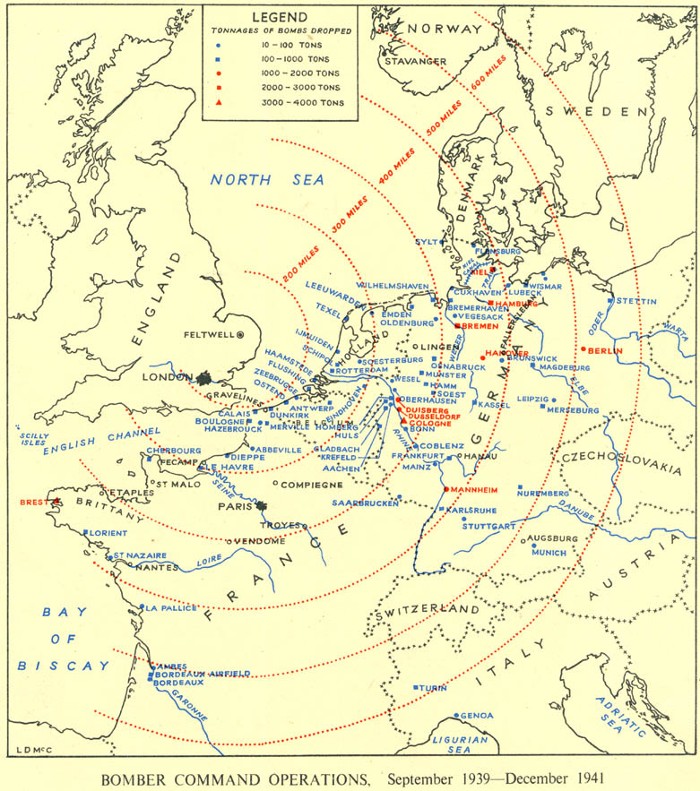
Bomber Command Operations, September 1939 - December 1941
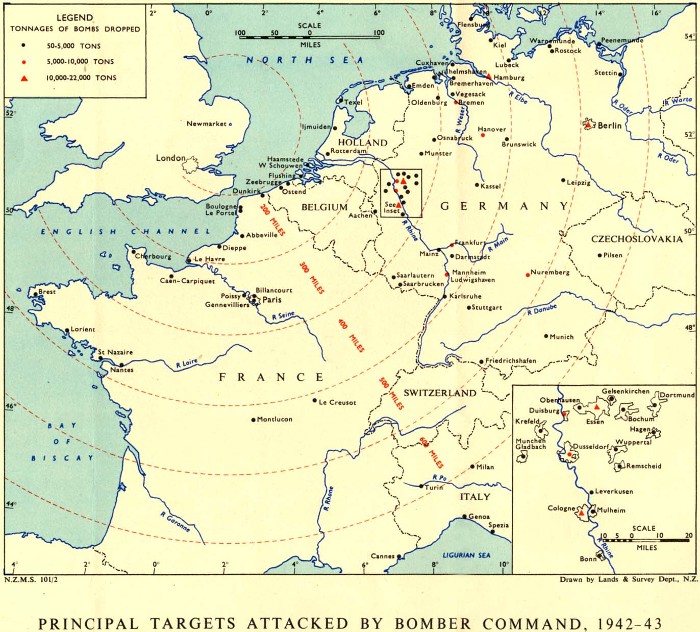
Principal Targets attacked by Bomber Command 1942-1943
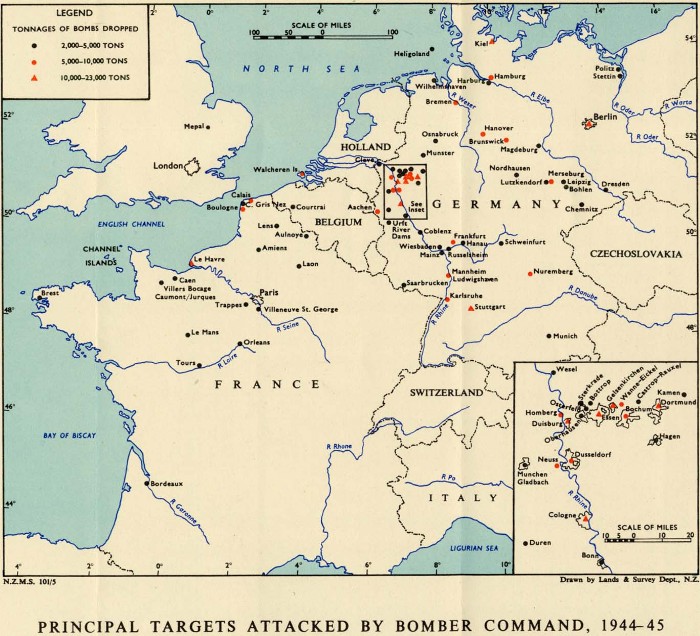
Principal Targets attacked by Bomber Command 1944-1945

Andreas Jordan, März 2009
|
↑ Top
|
|



![]()




